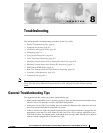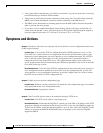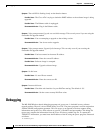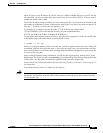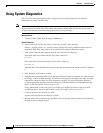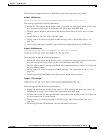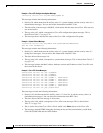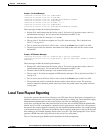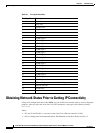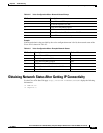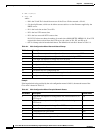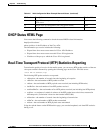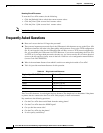
8-9
Cisco ATA 186 and Cisco ATA 188 Analog Telephone Adaptor Administrator’s Guide for MGCP (version 3.0)
OL-4803-01
Chapter 8 Troubleshooting
Local Tone Playout Reporting
Example—Fax Event Messages
<150>00:00:11 192.168.3.169 [10]:[1]MPT mode 0
<150>01:07:27 192.168.3.169 [10]:[1:0]Rx FAX
<150>01:07:27 192.168.3.169 [10]:[1]Tx MPT PT=100 NSE pkt c0000000
<150>01:07:27 192.168.3.169 [10]:[1]MPT mode 2
<150>01:07:27 192.168.3.169 [10]:[1]codec: 0 => 0
<150>01:07:27 192.168.3.169 [10]:[1]MPT mode 3
<150>01:07:27 192.168.3.169 [10]:[1]Rx MPT PT=100 NSE pkt c0000000
These messages include the following information:
• Priority=150, which means that the facility value is 18 (local use 2) and the severity value is 6
(informational messages). You can derive this information from RFC-3164.
• The time offset of the first message is 11 seconds.
• The tag value is 10, which corresponds to Cisco ATA event messages. This is derived from
Table 5-7 on page 5-42.
• The ch (active line of the Cisco ATA) is line 1, which is the Phone 2 port of the Cisco ATA..
• The messages include fax detection, transmit/receive NSE packet status and Fax codec switch
information.
Example—RTP Statistic Messages
<182>00:01:58 192.168.3.169 [16]:[0]RTP Tx dur:5, pkt:275, byte:44000
<182>00:01:58 192.168.3.169 [16]:[0]RTP Rx dur:7, pkt:226, byte:35921, latePkt:0 lostPkt:0
avgJitter:0
These messages include the following information:
• Priority=182, which means that the facility value is 22 (local use 6) and the severity value is 6
(informational messages). You can derive this information from RFC-3164.
• The time offset of the first message is one minute and 58 seconds.
• The tag value is 16, which corresponds to RTP statistics messages. This is derived from Table 5-7
on page 5-42.
• The ch (active line of the Cisco ATA) is line 0, which is the Phone 1 port of the Cisco ATA.
• The transmission statistics include the duration, packet count and byte count. The receiving
statistics include the duration, packet count, byte count, last packet count, lost packet count and
average jitter.
Local Tone Playout Reporting
Local tones are tones that the Cisco ATA plays to its FXS port. Each of these tones corresponds to an
identifier, and these tone type identifiers are placed into the prserv debug log. These identifiers supply
information that administrators can use to help analyze call flows for debugging purposes.
Local tones are different from other tones because local tones are not carried within the inband audio.
Instead, the Cisco ATA is prompted by a network event to play the tone, and the Cisco ATA generates
the tone for the exclusive purpose of playing it to the attached telephone handset. For example, during
a call between the Cisco ATA and a far-end phone, the far-end user might press a digit on the dial pad,
thus sending an AVT Named Signaling Event to the Cisco ATA. This event prompts the Cisco ATA to
generate a DTMF tone and to play the tone locally to the Cisco ATA phone.
Table 8-1 lists the tone type identifier and its description for local tone reporting.



